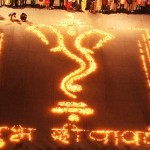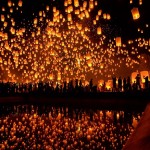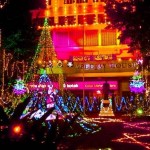Hindus have more than 33 million Gods and we celebrate almost as many festivals and occasions in the honor of our deities. But, inarguably Diwali is the best and the brightest of them all. Diwali is NOT just any other festival for the Hindus; it’s rather one of the most awaited and lavishly celebrated festivals in India. It is that time of the year when celebrations become a way of life and despite the dipping temperature there is warmth in the air. The malls look inviting, people splurge to their hearts content and family reunions happen.
Much like everything else in this country our festivals too have an interesting story behind them. But did you know that what is celebrated as Diwali in one part of the country is an equally auspicious occasion for many other religions and communities. So read along to know more fun facts about this festival of lights.
1. The birth and the marriage of Goddess Laxmi
It is believed that Goddess Lakshmi (the Goddess of wealth) was born on this day during the churning of the ocean by the Asuras and Devas (known as Samudra manthan). Goddess Laxmi was eventually married to Lord Vishnu on the very same new moon night of the year and luminous lamps were lit up to mark this holy occasion. Hence the association of Diwali with Goddess Lakshmi and the tradition of lighting of lamps and candles during the festival.
2. End of the Harvest Period
The fact that Diwali which is celebrated sometime in October/November which also overlaps with the end of a harvesting season, known as the Kharif season is no coincidence. Traditionally in India the celebration of Diwali was first started by the farmers after they reaped their harvests. On this day delicacies are prepared from pounded semi-cooked rice called Poha. This rice is taken from the fresh harvest available at that time. This custom is prevalent both in rural and urban areas especially in Western India.
3. Return of Ram
This one is the most popular reason, from one of India’s great epics, the Ramayana. It was the new moon day of Kartik when Lord Ram, Sita and Lakshman returned to Ayodhya after defeating Ravana and conquering Lanka. The citizens of Ayodhya decorated the entire city with earthen lamps and illuminated it in honor of the returning King and the rightful heir to the throne.
4. Lord Krishna Killed Narakaasur
While the rest of India celebrates Diwali on the new moon night, in Tamil Nadu, Diwali is traditionally celebrated on Naraka Chaturdasi(a day before Diwali). The legend goes something like this, that long ago there was demon king Narakaasur who had imprisoned around 16000 hapless women. Lord Krishna (8th incarnation of Lord Vishnu) saved the life of all those women by killing Narakaasur. From that day, it is celebrated to commemorate the victory of truth over the evil. In Goa, on this day, paper effigies of Narakasura, filled with grass and firecrackers symbolizing evil, are burnt. Some Tamil homes observe “nombu” and do Laxmi Pooja on this day.
5. Dedicated to Kali Pujo in Bengal
In keeping with the legend of Goddess Kali, Bengal celebrates Kali Puja on Diwali. Kali Puja is held on the night of the New Moon in the Bengali month of Kartik. It is said that Maharaja Krishnan Chandra of Nawadweep implored everyone, in his domain to worship Kali. As this puja was basically under the patronage of the rich and famous, it survived on a grand scale. Today, Kali puja is second in grandeur only to Durga puja in Bengal.
6. Lord Mahavira attained eternal bliss
Diwali has a very special significance in Jainism too. It marks anniversary of Lord Mahavira , the last of the Jain Tirthankar of this era, attaining nirvana.
7. Special day for the Sikh community
Among the Sikhs, Diwali came to have special connotation from the day the town of Amritsar was illuminated on the return to it of Guru Hargobind (1595-1644) who had been held captive in the Fort at Gwalior under the orders of the Mughal emperor, Jahangir (1570-1627). Hence forth Diwali, like Baisakhi, became a day of pilgrimage to the seat of the Gurus. The third Sikh Guru Amar Das institutionalized Diwali as a Red-Letter Day when all Sikhs would gather to receive the Gurus blessings.
8. Bestu Varas
Gujarati New Year: Bestu Varas marks the beginning of the harvest season in Gujarat and therefore is observed with great enthusiasm. It is celebrated as Gujarati New Year and falls on the day after Diwali. Similarly, Marwaris (Rajathani) celebrate their new year with Diwali.
9. Enlightenment of Swami Dayananda Saraswati
It was the new moon day of Kartik (Diwali day) when Maharshi Dayananda, one of the greatest reformers of Hinduism and the founder of the Arya Samaj attained his nirvana.
10. Return of the Pandavas to Kingdom
According to the great epic Mahabharata, it was Kartik Amavashya when the Pandavas appeared from their 12 years of banishment as a result of their defeat in the hands of the Kauravas at the game of dice (gambling). The countrymen who loved the Pandavas celebrated the day by lighting earthen lamps.
In a country as religiously diverse as ours there still may be several more legends and myths about Diwali; but each one of them is bound by a single spirit. It is about the significance of good overcoming evil, of hope empowering our hearts and souls. From darkness unto light- it’s the journey that brings us closer to ourselves.
Shubhra
Latest posts by Shubhra (see all)
- Nine destinations to look out for in 2015 - October 21, 2021
- Different reasons people celebrate Diwali across the Country - October 18, 2021
- Best International Holiday Destinations for Twentysomethings - September 13, 2021





















